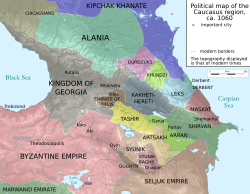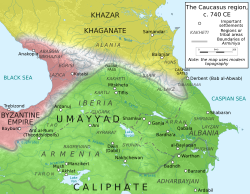
Back إمارة تفليسي Arabic Туплисалъул имарат AV Tiflis Müsəlman əmirliyi Azerbaijani Тбіліскі эмірат Byelorussian Тбилиски емират Bulgarian Emirat de Tbilissi Catalan Tbiliský emirát Czech Emirat von Tiflis German Emirato de Tiflis Spanish Émirat de Tbilissi French
Emirate of Tbilisi إمارة تفليسي Imārat Tiflisi (in Arabic) თბილისის საამირო Tbilisis saamiro (in Georgian) | |||||||||
|---|---|---|---|---|---|---|---|---|---|
| 736–1122 | |||||||||
 Emirate of Tbilisi in 1060. | |||||||||
| Capital | al-Tefelis | ||||||||
| Common languages | Classical Arabic, Georgian | ||||||||
| Religion | Sunni Islam, Eastern Orthodox Church | ||||||||
| Government | Emirate | ||||||||
| History | |||||||||
• Established | 736 | ||||||||
| 1122 | |||||||||
| |||||||||
| Today part of | Georgia | ||||||||
| Part of a series on the |
| History of Georgia |
|---|
 |
| Historical Arab states and dynasties |
|---|
 |
The Emirate of Tbilisi (Georgian: თბილისის საამირო Tbilisis saamiro, Arabic: إمارة تفليسي Imārat Tiflisi) was a Muslim emirate in Transcaucasia. The Emirs of Tbilisi ruled over the parts of today's eastern Georgia from their base in the city of Tbilisi, from 736 to 1080 (nominally to 1122). Established by the Arabs during their rule of Georgian lands, the emirate was an important outpost of the Muslim rule in the Caucasus until recaptured by the Georgians under King David IV in 1122.
